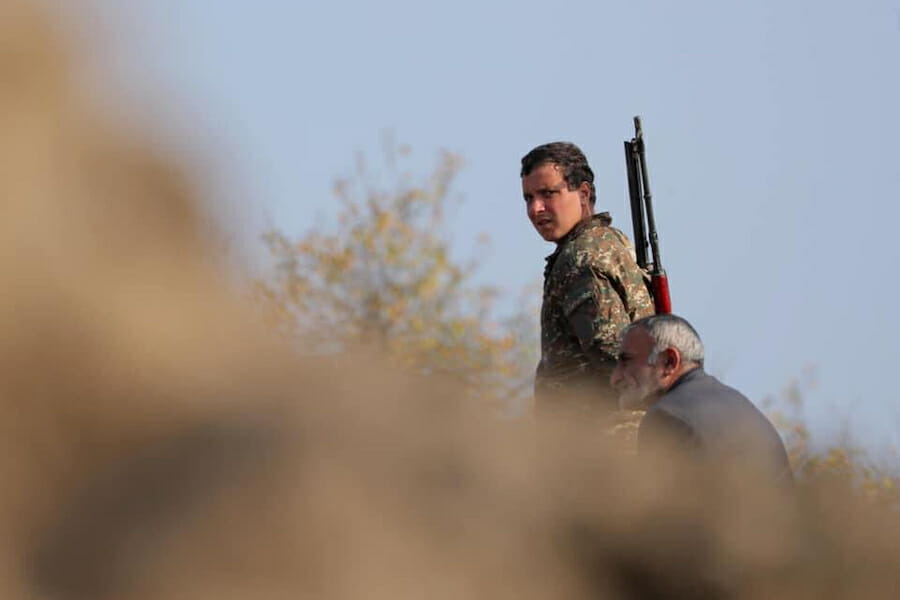
With Allies Unwilling to Back Armenia, is it Time to Change Course?
With the presidency decided in the United States, two countries in the South Caucasus have been fighting a little-covered war. U.S. leadership and experience in arbitrating disputes could play a key role in resolving this conflict, which goes back to the closing days of the Soviet Union and saw brutal fighting between Armenia and Azerbaijan.
While Armenia had won the war by 1994, in many ways it lost the peace, becoming increasingly isolated on the world stage.
With few options, Yerevan has been drawn into Moscow’s orbit, even reluctantly joining Moscow’s Eurasian Economic Union. Armenia faithfully purchased the majority of its military equipment from Russia, despite superior systems being available, under the belief that Russia would support their position in a crisis.
Iran, also in need of friends, became allies with Armenia over fears that Tehran’s large Azerbaijani population might soon prefer the rule of Baku to Iran’s Mullahs. Such policies have so far proved to be a dead-end as neither country has intervened to assist Armenia in its current war. Indeed, Russia has reiterated its support for Azerbaijan’s territorial integrity on the basis of international law.
Armenia’s fate is perhaps symbolized by the Medzamor Nuclear Power Plant. It was opposition to this facility on environmental grounds that led to some of the largest protests in the history of the Soviet Union in 1987 by Armenians. Built with an outdated design, it was deemed too dangerous to operate by Soviet authorities who shut it off in 1988 after a 6.9-magnitude earthquake struck just 75 kilometers away from the facility. Its closure was hailed as a victory and served as inspiration for Armenian patriots to dream of a future without communism.
Yet, Armenia was forced to sadly reactivate the facility just five years later. No less than National Geographic has wondered aloud if it is the world’s most dangerous nuclear reactor and one located just 30 km from the Armenian capital of Yerevan. In an unfortunate irony, a former prime minister claimed Armenia had developed its own nuclear weapons as recently as 2016.
Many Armenians, to use Lenin’s famous phrase, have in the decades since 1991 voted for peace with their feet and left the country. While this has been a problem in other post-communist nations, it has been more acute in Armenia. All of its neighbors have grown in population since 1991, but Armenia has declined. More worrying is the fact that citizens of those countries are also now richer than Armenia in per capita terms if international data can be trusted.
Like an outdated nuclear reactor, the powder keg that is Nagorno-Karabakh has produced a humanitarian disaster — four weeks of war between Armenia and Azerbaijan. The United States, in league with the international community, must lay out a clear policy designed at breaking the cycle of conflict and self-isolation to create a stable and prosperous Southern Caucasus region.
America must also carefully balance domestic concerns as the U.S. is home to a large Armenian-American community who have called for targeted sanctions against the government of Azerbaijan since the resumption of fighting.
Yet, multiple resolutions from the United Nations, the Council of Europe, and the European Parliament have recognized Nagorno-Karabakh as legally part of Azerbaijani territory.
Some argue the historical trauma of Armenia’s history requires the United States to ignore international law in this case. However, for the U.S to take sides in the conflict would be unbecoming of America’s role as a chair of OSCE Minsk Group which is focused on negotiating an end to this conflict.
In addition, Prime Minister Nikol Pashinyan has asked Russia for assistance, demonstrating that Armenia uses Russia repeatedly as a backstop in the conflict.
Azerbaijan can point to its own set of traumas such as the displacement of hundreds of thousands of IDPs from their homes during the Nagorno-Karabakh conflict.
This week Baku re-stated its commitment to autonomy for the region and left open the possibility of allowing international observers and peacekeepers to oversee any peace agreement. This gesture presents an opening that must be seized upon. Contemporary Azerbaijan, whatever its faults are, is a multicultural society home to Muslims, Jews, and Christians. Peace will require the vision and leadership to look to the future, not the past.
Here the United States and international organizations like the UN or OSCE can play a role by providing observers and potential peacekeepers to ensure that the rights of the population of Nagorno-Karabakh will be protected and that sacred sites are restored or protected after a cease-fire is signed.
American history also can be instructive. At the Camp David Accords in 1979, President Jimmy Carter forged a historic agreement between Egypt and Israel. One of the terms of that agreement was energy trade between the two nations. A similar mandate in a treaty between Armenia and Azerbaijan could compel the latter to sell petroleum products to energy-poor Armenia and work to ensure that surrounding states open their borders to Armenian trade.
The dreams of shutting down the Medzomar Nuclear Power Plant envisioned by Armenians back in 1987 might today finally become a reality. As well as their dreams for a more prosperous homeland as well as the dream of peace.
